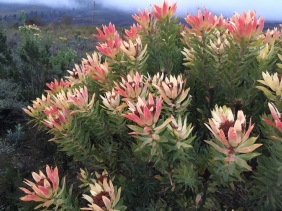The end of the affair
As I ran this morning with the dogs up a mountain thin with flowers I thought about all the many runs we’ve had, blogs I’ve written and flowers I’ve shared with the world through this blog. And I wondered, “why don’t I do it any more?” Why have I almost stopped blogging about the flowers and the farm?
Perhaps it’s done. I wrote the first blog in March 2013, so its no wonder I don’t find much that’s new to say about the run and the flowers.
I have much less time than I used to – a new business, like a new baby, demands incessant and urgent attention. Given more time, there will always be more to share – the weather alone is different every year; we have a cool January and even had heavy rain last night. That will be good for the end of buchu harvesting, though the wine farmers in the valley are less pleased.
We still run, the dogs and I and we still love and admire every moment of beauty that we come across. The dogs love a dose of wind or cooler weather and the feel of the wind slip-streaming through their coats.

Sometimes the girls leave us because it’s too hot and Maverick and I run alone.

This is the year of the locust. We often see them, but never so many as this year. I’m not a great animal photographer but those of us who grow up in Europe know locusts through the biblical stories of plagues so I thought it might be interesting to share some pictures of them. We come across them one at a time, which is fine, but you can imagine what a great cloud of these landing on your crops would be like, with their shark-like teeth, red wings and waspish body. Scary stuff. They are timid and move away quite quickly when we stop to look closer.
Although I have not been good at posting them, there are perennial favourites that I photograph again and again. One is the Peacock flower – Spiloxene capensis which has really benefited from the fires and is flowering like never before – all over the mountain and particularly on the driveway up to the farm. Thousands of these stud the mountain with white and green stars.
Another is the Leucodendron tincta. The flowers emerge as a yellowy lime green in the winter and in spring they turn the most beautiful shades of coral and terracotta.
Then there are the Aristeas. I have posted many of the subspecies over the years and this particular Aristea spiralis is always a treasure, another flower that has proliferated since the fires.
The other Aristeas are capitata and africana. Maverick helps to set off the splendid spikes of Aristea capitata high on the mountain. It loves damp places, close to rivers or along banks.

Aristea africana is a little thing, and likes to flourish where not much will, on dry rocky roads, alongside friends like pelargoniums and psuedoselagos.
Though too soon to announce a recovery of proteas and ericas, there are a few that survived the burning. I suspect I may revive this blog when they make a triumphant return. That will be two or three years for now, and if we are still here I will post the new life with great joy. In the meantime, here are some of the survivors.
























